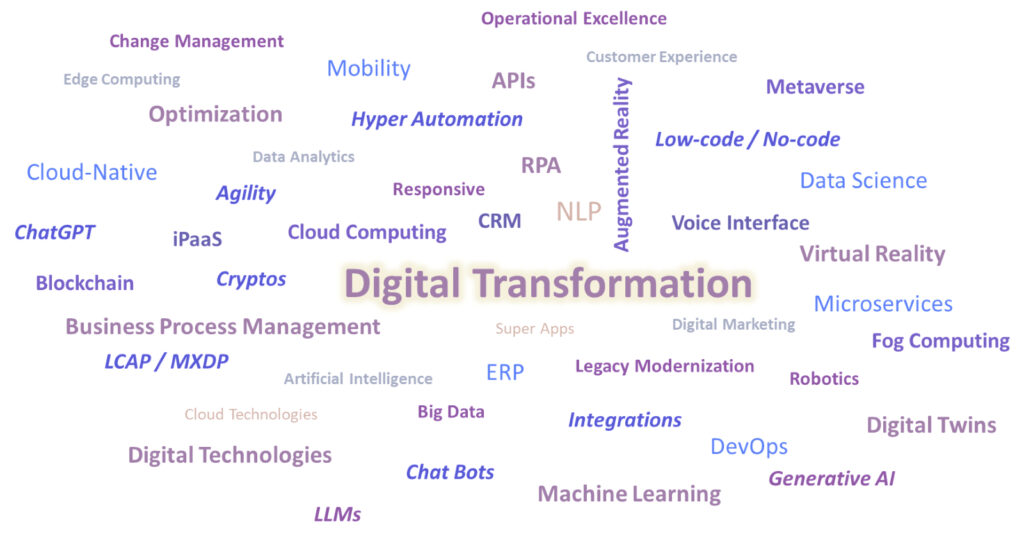Digital Transformation – What does it mean?
Much has been written and talked about Digital Transformation over the years. While many organizations have already embarked on the journey and are at different stages of accomplishment, many are yet contemplating or are in a planning stage. Digital transformation is interpreted differently by different people. The image below is a representation of its components. This diversity in perspectives can largely be attributed to the context and the goal, which drive the transformation efforts for an organization.

However, if we look closely, these are all just means to achieve a common goal i.e., transforming the way of working.
For organizations, to truly achieve the essence of Digital Transformation, they must understand that it’s not just the adoption of modern technologies, but a state of being wherein they transform themselves – of course, with technology playing a part to help them be:
- More efficient in their operations.
- More agile in responding to the changing market dynamics.
- More resilient to the disruptions.
- Better with customer experiences.
- Innovative in their offerings.
- Quicker in keeping pace with the changing technology landscape.
- More accommodative, and responsive by culture.
Why do organizations even need to care about Digital Transformation?
For an organization, irrespective of the industry, there are a few ‘must-haves’ to function and sustain, and those are:
- Products and services to offer – the very reason for an enterprises’ existence.
- Departments / Functions to carry out the operations required to offer the products / services.
- Operational processes to support these functions.
- IT infrastructure to support / execute the processes.
- Decision support system / MIS to support the decision making and strategy formulation.
However, these components are bound to shake a little, go off track, and develop inefficiencies as well as deficiencies over time due to changing business and technology environments. They need to be reinvented and / or realigned to stay relevant to the cause. The products need to be enhanced with newer features demanded by end-consumers. Operational processes become sloppy over time and need to be streamlined or standardized again. The IT infrastructure and application landscape must be revamped to keep up with the evolving technologies.
This evolution is a continuous phenomenon. Organizations need to futureproof themselves today to respond to the challenges and exploit the opportunities of tomorrow, and that is why digital transformation is high on the agenda for CXOs.
The Transformation Priorities
The CXOs across organizations are facing the mandate to be future ready while also responding to the challenges of today. In a world which is getting back up on its feet post pandemic, and which has witnessed multiple technology revolutions to cope with (e.g., cloud computing, artificial intelligence – the force behind machines rubbing shoulders with humans, large language models (LLMs), low-code / no-code platforms, APIs and many more), organizations are compelled to reinvent themselves. And that calls for identifying and prioritising the transformation initiatives throughout the organization.
Here is a quick guide on where the focused transformation efforts will have visible outcomes:
Modernization: In addition to rewriting the applications (internal facing as well as external facing) with emerging technologies, modernisation can be brought about via revamping the architecture and the underlying infrastructure. For example, redeveloping self-service customer portals using cloud-native low-code technology platforms. This gives better customer experience with modern interfaces, resilience in terms of architecture, and scalable infrastructure.
Process Automation and Optimization: In the overall scheme of an enterprise application landscape, there are multiple processes which run as the lifeblood. However, the productivity could be marred if they start to bleed (in other words, develop inefficiencies) due to workarounds, manual touchpoints or by the complexity of the process itself. To recover from the loss, those processes must be realigned and optimized to achieve operational excellence. This can be achieved via process standardization and automation with the help of continuous improvement philosophies, robotic process automation (RPA), and process orchestration platforms (iPaaS) for seamless stitching of the processes.
Integrated Application Landscape: With the rise in SaaS applications, and subscription economy, you need not always have in-house development of the applications you need. You can always find a solution which serves your requirements (with required customizations on top of the base version) and pay only for what you need / use. This holds true for applications across the value chain – be it CRM, eCommerce Store, Customer Support System, ERP, MES, and / or Logistics. All you need is an integration platform which keeps all the applications in sync with low-latency connectivity – which too are available on subscription.
Customer Experience: This is the main driver of any organization’s transformation efforts – experience transformation for internal as well as external customers. Ideally, this must be given the most weightage when planning any transformation because ‘an experience to remember’ must be the outcome of any such efforts. Experience transformation is the reason behind all the evolutions in technology, products, service, and business models. Artificial intelligence, machine learning, robotics, big data analytics, blockchain, AR / VR, metaverse, IOT (M2M communication), low-code / no-code development, and super apps are some of these modern technologies which are enabling a WOW experience to customers.
Leverage Data: No one can argue against the data supremacy in the world we live in. Data is the new air without which organizations cannot breathe in today’s business and technology environment. The unprecedented amount of data that is being generate by the sensors, the mobile devices, the tracking devices/application, and the networking / sharing applications doesn’t seem to be slowing down, rather is bound to increase exponentially. In such environment, the best approach is to make the data work for you. Just like how the data is available in abundance, there is no dearth of data processing technologies either. All you need to do is to make the data traverse through your data pipeline into your data store and then process it to extract relevant insights, trends, and patterns. These insights could guide your decision making, could help you with predictive and prescriptive models, and could well lead the AI solutions for your business.
What it takes?
‘People’, ‘Process’, and ‘Technology’ are the three areas which see the most transformation efforts being directed to. We have already talked a bit about ‘Process’ and ‘Technology’, however it’s ‘People’ who actually make it happen. For any organization to successfully achieve the objectives of digital transformation initiatives, its people need to be aligned with the strategy. They not only need to be receptive to the change but also embrace it. This calls for a cultural shift – to accept and bring about the changes that are envisioned, to be more adaptive, agile, accommodative, and responsive.
Transformation is a costly, time consuming, and effort intensive affair. It doesn’t come overnight and requires targeted efforts from across the organization. To be truly achieving what the organization has set out to achieve, all resources must be focused on the given objectives. Great transformations are results of a well thought through transformation strategy with clearly defined goals and objectives, a transformation roadmap to achieve those goals over the defined period of time, and key indicators to measure the accomplishments against the goals. To ensure that the transformation efforts are yielding results, there needs to be a governance mechanism to track and monitor the outcomes. All this is possible only when people adopt a transformation mindset, and CXOs are watching over. It is imperative that the transformation initiatives are driven by and closely monitored at the highest level.
Successful transformation initiatives take strategic guidance, funding, and people who want it to make it happen. According to one of McKinsey research, about 70% transformation initiatives fail due to lack of vision, leadership support, change management, and long-term commitment from people.
Let’s put it all together…
In the last decade, we have seen many new development and infrastructure technologies along with innovative products and business models which focus on providing an experience that can attract and hold customers. We have also seen organizations focusing on efficiencies throughout the value chain in order to be more lean and agile. The business processes are getting simpler and more automated, the interfaces are becoming more intuitive and provide seamless experience across touchpoints, the infrastructures are more scalable and resilient, and the products and services are becoming more personalised.
Organizations now – more than ever – realize the importance of bringing the transformative change in their way of working. While some make it a strategic priority, some act out of FOMO. Some follow it through to successful completion, while some struggle to accomplish what they had planned for.
Whatever be the state of transformation in your organization, it is now no more a matter of ‘if’ but ‘when’ you make it happen.
A word of caution though, don’t do it for the sake of doing it, or just because others are doing it – first assess, then embrace. Assess your needs, do your own due diligence, and choose what fits best to your use-case, and gives you the best results and ROI.
About the Author
Avinash serves as Solution Architect for Digital Solutions at Zimetrics. He brings extensive experience in solving business problems of varied complexity across different industries and domains. He is an expert when it comes to end-to-end solutioning, business process management, and low-code / no-code technologies.


